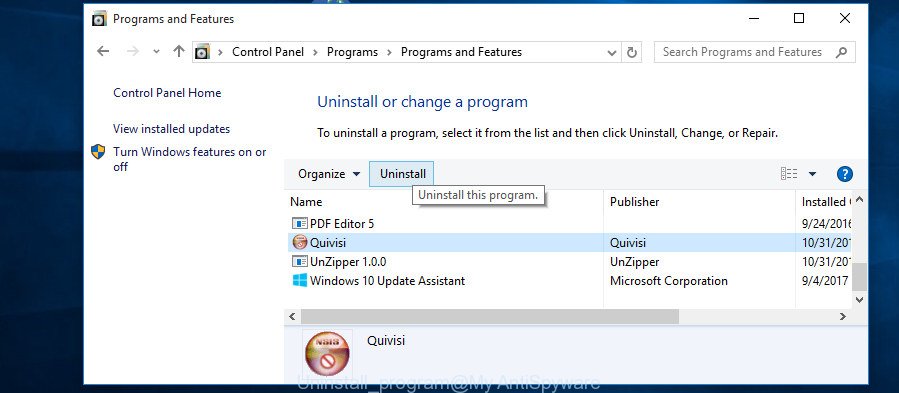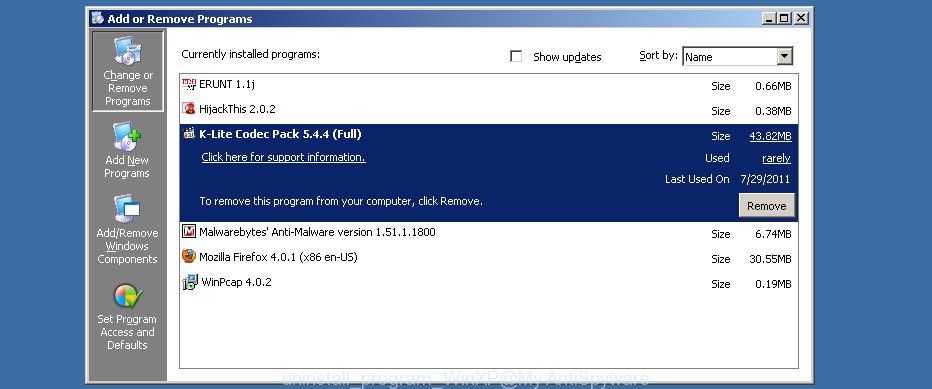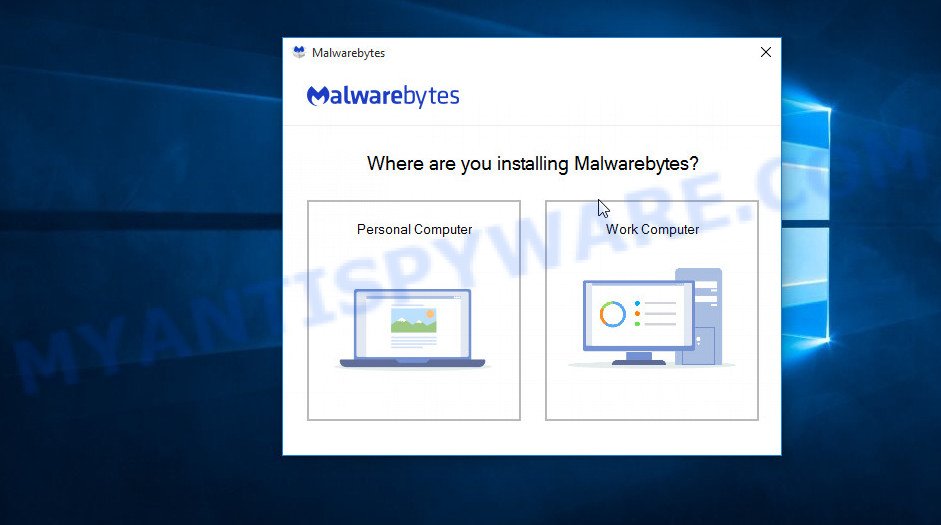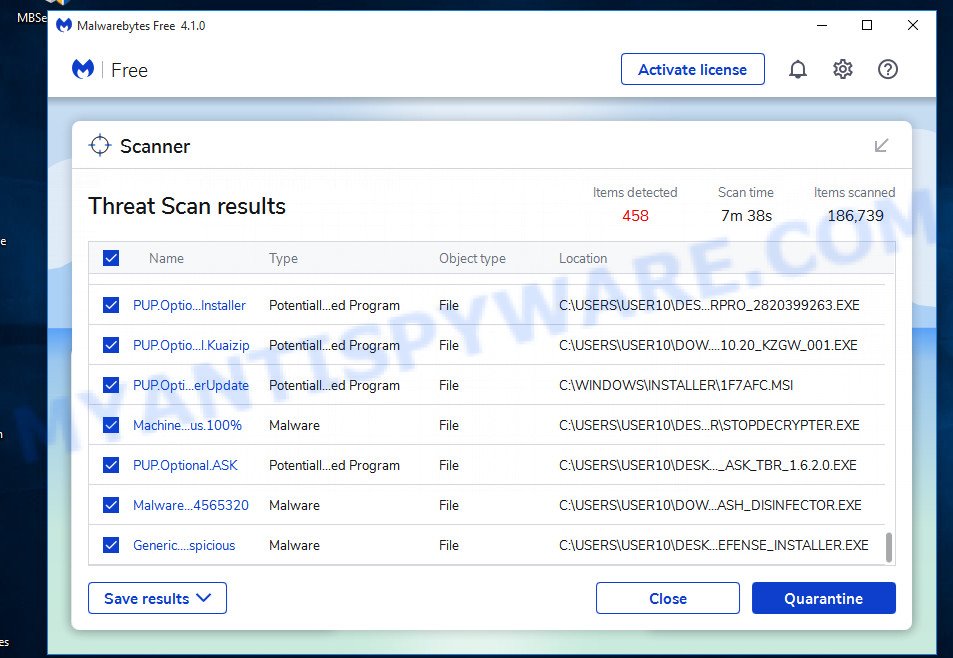What is Another-notification.one?
Another-notification.one is a web-site that uses the browser notification feature to trick you and other unsuspecting victims into accepting push notifications via the internet browser. Push notifications are originally created to alert users of recently published blog posts. Scammers abuse ‘browser notification feature’ to avoid antivirus and adblocker apps by showing annoying adverts. These advertisements are displayed in the lower right corner of the screen urges users to play online games, visit questionable webpages, install internet browser addons & so on.

Another-notification.one is a misleading site that delivers a message stating that you should click ‘Allow’ in order to access the content of the website, download a file, connect to the Internet, watch a video, enable Flash Player, and so on. Once enabled, the Another-notification.one notifications will start popping up in the lower right corner of the desktop periodically and spam the user with annoying ads.

Threat Summary
| Name | Another-notification.one pop-up |
| Type | spam push notifications, browser notification spam, pop-up virus |
| Distribution | misleading popup ads, adware software, PUPs, social engineering attack |
| Symptoms |
|
| Removal | Another-notification.one removal guide |
How does your computer get infected with Another-notification.one popups
Some research has shown that users can be redirected to Another-notification.one from misleading advertisements or by PUPs and adware software. Adware is a type of software that is designed for the purpose of displaying constant pop-ups and/or annoying advertisements on the infected personal computer without the user’s consent.
Adware usually gets installed alongside free programs, codecs and shareware. Which means that you need to be proactive and carefully read the Terms of use and the License agreement properly. For the most part, adware will be clearly described, so take the time to carefully read all the information about the software that you downloaded and want to install on your computer.
Remove Another-notification.one notifications from internet browsers
If you have allowed the Another-notification.one site to send browser notifications to your web browser, then we’ll need to delete these permissions. Depending on web-browser, you can execute the steps below to delete the Another-notification.one permissions to send browser notifications.
Google Chrome:
- Click on ‘three dots menu’ button at the top-right corner of the Google Chrome window.
- Select ‘Settings’. Then, scroll down to the bottom where it says ‘Advanced’.
- At the ‘Privacy and Security’ section click ‘Site settings’.
- Go to Notifications settings.
- Click ‘three dots’ button on the right hand side of Another-notification.one URL or other questionable URL and click ‘Remove’.

Android:
- Tap ‘Settings’.
- Tap ‘Notifications’.
- Find and tap the web-browser that shows Another-notification.one notifications advertisements.
- Locate Another-notification.one site in the list and disable it.

Mozilla Firefox:
- In the top-right corner, click the Firefox menu (three horizontal stripes).
- In the drop-down menu select ‘Options’. In the left side select ‘Privacy & Security’.
- Scroll down to ‘Permissions’ section and click ‘Settings…’ button next to ‘Notifications’.
- Select the Another-notification.one domain from the list and change the status to ‘Block’.
- Save changes.

Edge:
- In the top right corner, click the Edge menu button (it looks like three dots).
- Scroll down, locate and click ‘Settings’. In the left side select ‘Advanced’.
- In the ‘Website permissions’ section click ‘Manage permissions’.
- Disable the on switch for the Another-notification.one.

Internet Explorer:
- In the right upper corner of the window, click on the gear icon (menu button).
- Go to ‘Internet Options’ in the menu.
- Select the ‘Privacy’ tab and click ‘Settings under ‘Pop-up Blocker’ section.
- Select the Another-notification.one site and other dubious sites under and delete them one by one by clicking the ‘Remove’ button.

Safari:
- On the top menu select ‘Safari’, then ‘Preferences’.
- Select the ‘Websites’ tab and then select ‘Notifications’ section on the left panel.
- Check for Another-notification.one site, other dubious URLs and apply the ‘Deny’ option for each.
How to remove Another-notification.one pop-up ads from Chrome, Firefox, IE, Edge
In order to remove Another-notification.one popups from the Internet Explorer, MS Edge, Mozilla Firefox and Google Chrome, you need to reset the internet browser settings. Additionally, you should look up for other dubious entries, such as files, programs, web-browser extensions and shortcuts. However, if you want to remove Another-notification.one pop up advertisements easily, you should run reputable anti-malware tool and let it do the job for you.
To remove Another-notification.one pop ups, complete the following steps:
- Remove Another-notification.one notifications from internet browsers
- Manual Another-notification.one pop-ups removal
- Automatic Removal of Another-notification.one pop up advertisements
- Stop Another-notification.one ads
Manual Another-notification.one pop-ups removal
The step-by-step tutorial will help you manually get rid of Another-notification.one redirect from your PC. If you have little experience in using computers, we suggest that you use the free utilities listed below.
Remove newly installed potentially unwanted programs
We recommend that you start the computer cleaning procedure by checking the list of installed programs and delete all unknown or questionable programs. This is a very important step, as mentioned above, very often the harmful applications such as adware and hijackers may be bundled with free programs. Delete the unwanted applications can remove the intrusive advertisements or web-browser redirect.
Make sure you have closed all internet browsers and other software. Next, remove any unknown and suspicious apps from your Control panel.
Windows 10, 8.1, 8
Now, press the Windows button, type “Control panel” in search and press Enter. Select “Programs and Features”, then “Uninstall a program”.

Look around the entire list of apps installed on your device. Most likely, one of them is the adware responsible for the Another-notification.one redirect. Choose the questionable program or the program that name is not familiar to you and uninstall it.
Windows Vista, 7
From the “Start” menu in MS Windows, select “Control Panel”. Under the “Programs” icon, choose “Uninstall a program”.

Select the dubious or any unknown apps, then click “Uninstall/Change” button to remove this undesired program from your computer.
Windows XP
Click the “Start” button, select “Control Panel” option. Click on “Add/Remove Programs”.

Select an unwanted program, then click “Change/Remove” button. Follow the prompts.
Get rid of Another-notification.one pop-up ads from Internet Explorer
In order to restore all web browser newtab page, homepage and search engine you need to reset the Internet Explorer to the state, which was when the MS Windows was installed on your personal computer.
First, start the Microsoft Internet Explorer, then click ‘gear’ icon ![]() . It will show the Tools drop-down menu on the right part of the web-browser, then press the “Internet Options” like below.
. It will show the Tools drop-down menu on the right part of the web-browser, then press the “Internet Options” like below.

In the “Internet Options” screen, select the “Advanced” tab, then click the “Reset” button. The Microsoft Internet Explorer will display the “Reset Internet Explorer settings” prompt. Further, click the “Delete personal settings” check box to select it. Next, click the “Reset” button such as the one below.

When the procedure is complete, click “Close” button. Close the Microsoft Internet Explorer and reboot your computer for the changes to take effect. This step will help you to restore your web browser’s newtab, home page and default search engine to default state.
Delete Another-notification.one redirect from Mozilla Firefox
If Firefox settings are hijacked by the adware, your internet browser shows unwanted pop up ads, then ‘Reset Mozilla Firefox’ could solve these problems. When using the reset feature, your personal information such as passwords, bookmarks, browsing history and web form auto-fill data will be saved.
First, run the Mozilla Firefox. Next, click the button in the form of three horizontal stripes (![]() ). It will show the drop-down menu. Next, click the Help button (
). It will show the drop-down menu. Next, click the Help button (![]() ).
).

In the Help menu click the “Troubleshooting Information”. In the upper-right corner of the “Troubleshooting Information” page press on “Refresh Firefox” button like below.

Confirm your action, click the “Refresh Firefox”.
Remove Another-notification.one pop ups from Chrome
Reset Chrome settings to remove Another-notification.one popups. If you’re still experiencing problems with Another-notification.one advertisements removal, you need to reset Google Chrome browser to its default values. This step needs to be performed only if adware has not been removed by the previous steps.
First start the Google Chrome. Next, click the button in the form of three horizontal dots (![]() ).
).
It will display the Google Chrome menu. Choose More Tools, then press Extensions. Carefully browse through the list of installed extensions. If the list has the add-on signed with “Installed by enterprise policy” or “Installed by your administrator”, then complete the following guidance: Remove Google Chrome extensions installed by enterprise policy.
Open the Google Chrome menu once again. Further, click the option called “Settings”.

The web browser will show the settings screen. Another method to show the Google Chrome’s settings – type chrome://settings in the web browser adress bar and press Enter
Scroll down to the bottom of the page and click the “Advanced” link. Now scroll down until the “Reset” section is visible, as on the image below and click the “Reset settings to their original defaults” button.

The Google Chrome will open the confirmation dialog box as on the image below.

You need to confirm your action, click the “Reset” button. The internet browser will launch the task of cleaning. When it’s done, the browser’s settings including search provider by default, newtab and home page back to the values which have been when the Chrome was first installed on your computer.
Automatic Removal of Another-notification.one pop up advertisements
AntiMalware applications differ from each other by many features such as performance, scheduled scans, automatic updates, virus signature database, technical support, compatibility with other antivirus programs and so on. We suggest you run the following free software: Zemana AntiMalware, MalwareBytes AntiMalware and HitmanPro. Each of these programs has all of needed features, but most importantly, they have the ability to identify the adware and get rid of Another-notification.one pop-up advertisements from the Google Chrome, Internet Explorer, Firefox and Edge.
Run Zemana Anti Malware to get rid of Another-notification.one redirect
Zemana Free is a malware removal tool designed for Microsoft Windows. This tool will help you remove Another-notification.one pop up advertisements, various types of malware (including browser hijackers and PUPs) from your computer. It has simple and user friendly interface. While the Zemana does its job, your computer will run smoothly.
Now you can set up and use Zemana AntiMalware to remove Another-notification.one redirect from your internet browser by following the steps below:
Click the following link to download Zemana Anti-Malware installation package named Zemana.AntiMalware.Setup on your PC system. Save it on your Microsoft Windows desktop or in any other place.
165033 downloads
Author: Zemana Ltd
Category: Security tools
Update: July 16, 2019
Start the installer after it has been downloaded successfully and then follow the prompts to install this tool on your personal computer.

During install you can change some settings, but we advise you don’t make any changes to default settings.
When installation is done, this malicious software removal utility will automatically start and update itself. You will see its main window as shown on the image below.

Now click the “Scan” button to perform a system scan for the adware that causes the intrusive Another-notification.one pop-up advertisements. A system scan can take anywhere from 5 to 30 minutes, depending on your computer. When a threat is found, the count of the security threats will change accordingly. Wait until the the scanning is finished.

As the scanning ends, Zemana AntiMalware will display you the results. In order to remove all threats, simply click “Next” button.

The Zemana will get rid of adware which causes popups and move the selected items to the program’s quarantine. Once disinfection is finished, you may be prompted to restart your computer to make the change take effect.
Delete Another-notification.one pop up advertisements and malicious extensions with Hitman Pro
Hitman Pro is a portable tool which detects and uninstalls unwanted programs like hijackers, adware software, toolbars, other web browser add-ons and other malware. It scans your computer for adware related to the Another-notification.one pop up ads and prepares a list of items marked for removal. HitmanPro will only erase those unwanted applications that you wish to be removed.

- Download HitmanPro from the following link.
- When downloading is finished, double click the Hitman Pro icon. Once this tool is started, click “Next” button to start checking your PC system for the adware software associated with the Another-notification.one pop up ads. Depending on your PC, the scan can take anywhere from a few minutes to close to an hour. While the Hitman Pro application is scanning, you may see how many objects it has identified as threat.
- After Hitman Pro has completed scanning your PC system, Hitman Pro will show a scan report. You may delete items (move to Quarantine) by simply click “Next” button. Now click the “Activate free license” button to start the free 30 days trial to remove all malicious software found.
Remove Another-notification.one advertisements with MalwareBytes AntiMalware (MBAM)
You can remove Another-notification.one advertisements automatically through the use of MalwareBytes Anti-Malware (MBAM). We advise this free malware removal utility because it can easily remove hijackers, adware software, potentially unwanted apps and toolbars with all their components such as files, folders and registry entries.
MalwareBytes can be downloaded from the following link. Save it to your Desktop.
327261 downloads
Author: Malwarebytes
Category: Security tools
Update: April 15, 2020
After the download is finished, close all apps and windows on your computer. Open a directory in which you saved it. Double-click on the icon that’s called MBSetup like the one below.
![]()
When the installation starts, you will see the Setup wizard that will help you setup Malwarebytes on your computer.

Once installation is finished, you’ll see window as on the image below.

Now press the “Scan” button to perform a system scan for the adware responsible for the Another-notification.one popup advertisements. Depending on your PC, the scan can take anywhere from a few minutes to close to an hour. While the MalwareBytes Anti-Malware is scanning, you can see count of objects it has identified either as being malicious software.

Once MalwareBytes Anti Malware has completed scanning, you can check all threats found on your personal computer. Make sure to check mark the threats which are unsafe and then click “Quarantine” button.

The Malwarebytes will now start to get rid of adware that causes the unwanted Another-notification.one pop-up ads. When that process is finished, you may be prompted to restart your device.

The following video explains few simple steps on how to get rid of browser hijacker, adware software and other malicious software with MalwareBytes Free.
Stop Another-notification.one ads
If you surf the Web, you can’t avoid malicious advertising. But you can protect your web-browser against it. Download and run an ad blocking program. AdGuard is an ad blocking that can filter out a ton of of the malicious advertising, blocking dynamic scripts from loading harmful content.
- Visit the following page to download the latest version of AdGuard for MS Windows. Save it to your Desktop.
Adguard download
26897 downloads
Version: 6.4
Author: © Adguard
Category: Security tools
Update: November 15, 2018
- After downloading it, run the downloaded file. You will see the “Setup Wizard” program window. Follow the prompts.
- When the setup is done, press “Skip” to close the setup program and use the default settings, or click “Get Started” to see an quick tutorial which will help you get to know AdGuard better.
- In most cases, the default settings are enough and you don’t need to change anything. Each time, when you start your device, AdGuard will run automatically and stop undesired advertisements, block Another-notification.one, as well as other harmful or misleading web pages. For an overview of all the features of the program, or to change its settings you can simply double-click on the icon called AdGuard, that is located on your desktop.
To sum up
Now your computer should be free of the adware software associated with the Another-notification.one popup advertisements. We suggest that you keep AdGuard (to help you stop unwanted advertisements and intrusive malicious web pages) and Zemana Anti-Malware (ZAM) (to periodically scan your PC system for new adwares and other malware). Probably you are running an older version of Java or Adobe Flash Player. This can be a security risk, so download and install the latest version right now.
If you are still having problems while trying to remove Another-notification.one pop ups from the MS Edge, Mozilla Firefox, Chrome and Microsoft Internet Explorer, then ask for help here here.



















